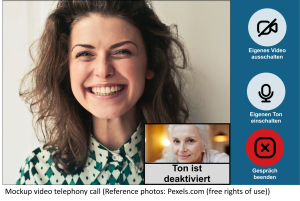Mockup design, prototype development and usability evaluation of a tablet-based videotelephony application for the low media literate elderly
Aim and Research Question(s)
The aim of this thesis was to develop a mockup, prototypically implement it on a tablet and evaluate it. Therefore, the following research questions were answered: I: Which functional and non-functional requirements for the user interface design of a tablet-based videotelephony application for elderly people with low media literacy can be identified? II: What steps in designing and developing are required to prototype a tablet-based videotelephony application for the elderly with low media literacy? III: What are the usability test results of a prototypical videotelephony application for the low media literate elderly using the quantitative metrics time on task, task completion, and system usability scale and the feedback of a semi-structured interview?
Background
In old age, more and more people are dependent on additional help and care. Often, social contacts decrease with increasing age. This can lead to loneliness. The problem of loneliness and social isolation can be countered by using digital communication with the help of videotelephony [1].
Methods
To offer users of the assistance system of the company BeHome a solution for videotelephony that corresponds to the technical abilities and needs of older people, a prototype of an application for videotelephony was developed. Therefore, the identification of requirements, the design of a mockup, and in collaboration with BeHome, the prototypical implementation in the form of an application on the system's tablet took place. For developing the application, the Vonage Video API was used. The developed solution was evaluated with five end-users in terms of usability.
Results and Discussion
When developing an app for videotelephony, functional requirements, such as establishing a video connection between two users and non-functional requirements, such as usability, must be taken into account. The evaluation of the developed solution shows a good usability. At the same time, measures for improvement, like displaying the contacts in an alternative way were identified. It became apparent that there are barriers to the implementation. The use of the Vonage Video API leads to an additional effort on the part of the potential videotelephony contacts. To circumvent this, it is possible to fall back on already widespread and frequently used solutions for videotelephony, such as WhatsApp. However, this offers fewer possibilities to adapt the application and there is a risk of reduced user-friendliness on the part of the older users.
Conclusion
All in all, the findings of this thesis indicate the importance of considering the specific needs and capabilities of the elderly users and their potential videotelephony contacts in the application development to create a suitable and usable solution. Further studies should consider the user perspective of the contacts in more detail.
References
[1] Garattini, C., Wherton, J., & Prendergast, D. (2012). Linking the lonely: An exploration of a communication technology designed to support social interaction among older adults. Universal Access in the Information Society, 11(2), 211–222. https://doi.org/10.1007/s10209-011-0235-y
